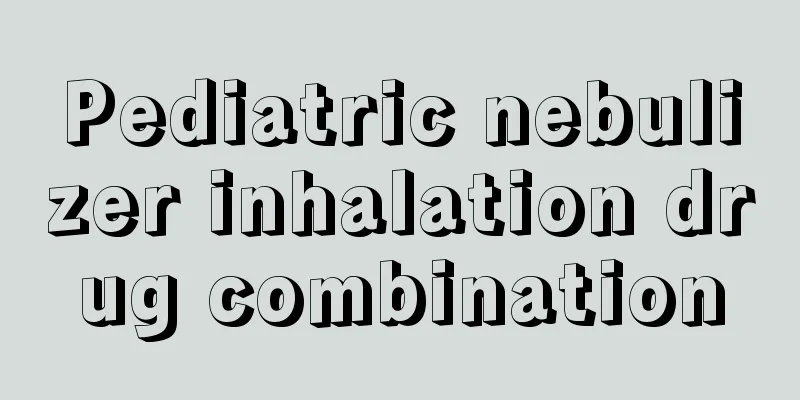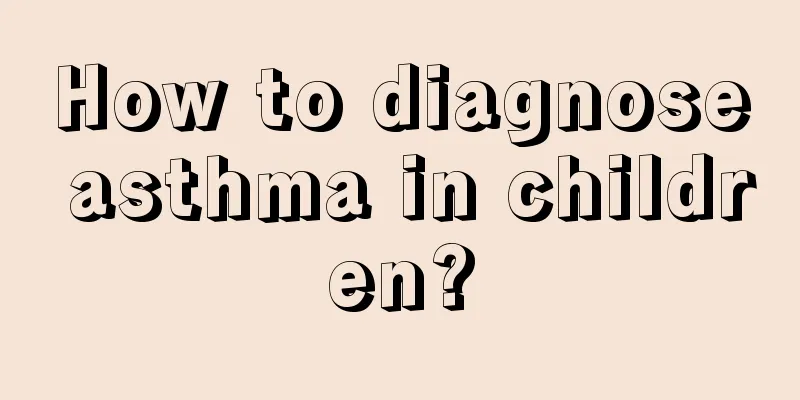Pediatric nebulizer inhalation drug combination

|
Giving children medicine is a huge task for many parents and doctors, especially when the children are younger and you cannot communicate with them at all. Therefore, many medicines given to children are in liquid form or nebulized. However, nebulized medicines are generally used to treat bronchial diseases. For example, bronchodilators are used to treat bronchospasm, budesonide is used to treat childhood asthma by reducing inflammation, and antibiotics can treat respiratory infections. 1. Bronchodilators: Mainly used to relieve bronchospasm. Commonly used drugs include: The commonly used anticholinergic drug is ipratropium bromide, and the concentration of aqueous solution is 0.025%. Adults take 2 ml each time, children take 0.4-1 ml each time, add an equal amount of normal saline solution and nebulize for inhalation, or you can directly inhale the original solution, 2-3 times a day. 10% to 30% of the inhaled dose is deposited in the lungs, with less absorbed by the gastrointestinal mucosa. It has a high selectivity for respiratory smooth muscle. It takes effect 10 to 30 minutes after inhalation, reaches its peak effect in 1 to 2 hours, and the effect can last for 6 to 8 hours after one inhalation. It is mainly used to treat acute attacks of COPD and bronchial asthma. The drug has minimal adverse reactions, but there have been reports of acute urinary retention after inhalation. Therefore, it should be used with caution in patients with prostate hypertrophy, glaucoma, and pregnant or lactating women. The β2 receptor agonists currently commonly used in clinical practice include salbutamol. The concentration of its aqueous solution is 0.05%. After atomization, it forms aerosol particles with a diameter of 2~4 μm. After inhalation, 10%~20% of the drug can reach the lower respiratory tract. The usual dose is 2 ml of the drug plus an equal amount of normal saline for nebulized inhalation. It takes effect 5 minutes after inhalation, reaches its peak in 15 minutes, and the efficacy can last for 4 to 6 hours. It is mainly used for patients with severe bronchial asthma attacks and COPD with obvious bronchospasm. Since this type of drug also has a partial stimulatory effect on the beta receptors of the heart and skeletal muscles, some patients may experience palpitations and skeletal muscle tremors after inhalation. Patients with organic heart disease, hypertension, and hyperthyroidism should use this type of drug with caution. 2. Glucocorticoids: They are highly effective locally and safe throughout the body. Commonly used drugs include: The drug concentration of budesonide is 1 mg/2 ml, 2 ml is used each time, 2 to 3 times a day. About 10% of the drug administered via aerosol is deposited in the lungs, with a distribution volume of about 300 L in adults and 3.1-4.8 L/kg in children, indicating that it has a high tissue affinity and can exert a strong local anti-inflammatory effect, and a small dose can have a therapeutic effect. Nebulized inhalation of budesonide takes effect quickly and can exert airway anti-inflammatory effects within 10 to 30 minutes. It is suitable for the treatment of acute attacks of severe bronchial asthma, especially for children with asthma. The therapeutic effect will be better if it is combined with anticholine drugs and/or β2 receptor agonists for nebulization inhalation. It should be noted that doctors should advise patients to rinse their mouths thoroughly after nebulization inhalation to prevent Candida infection of the oral cavity and pharyngeal mucosa. 3. Mucolytics Although α-chymotrypsin can reduce the viscosity of sputum, making it dilute and easier to expel, long-term aerosol inhalation can lead to squamous metaplasia of the airway epithelium and occasionally cause allergic reactions. It is rarely used nowadays. Ambroxol hydrochloride can regulate the secretion of respiratory epithelial serous fluid and mucus; stimulate alveolar type II epithelial cells to synthesize and secrete alveolar surfactant to maintain alveolar stability; increase the movement of respiratory epithelial cilia to make sputum easier to cough up. The solution concentration is 15 mg/ml. Adults take 2-4 ml each time, 2-3 times a day by nebulization. 4. Antibiotics: Nebulized inhalation of antibiotics has a certain therapeutic effect on respiratory infections. Intermittent or short-term prophylactic inhaled antibiotics can effectively reduce the colonization rate of Gram-negative bacteria in the upper respiratory tract. At present, aerosol inhalation of antibiotics is mainly used in clinical practice to treat hospital-acquired pneumonia in critically ill patients with Gram-negative bacterial infection. It is important to note that the surface fluid covering the respiratory epithelium is isotonic and has a neutral pH. Inhaled antibiotics with high osmotic pressure or low pH can cause coughing and even airway spasm. The pH values of tobramycin sulfate and ceftazidime are suitable for inhalation administration. The inhaled antibiotics should be dissolved in normal saline at a concentration of 100 mg/ml. |
<<: There are many small red spots on the tongue of a seven-month-old baby
>>: What's wrong with the bloodshot on the child's face?
Recommend
What causes breast lumps in little girls?
When a girl's body is developing, her hormone...
Does baby eczema itch?
After getting eczema, the child will become very ...
What are the dietary remedies for babies' sneezing and runny nose?
What are the dietary remedies for babies' sne...
How to make delicious baby butterfly noodles
After the baby has been drinking breast milk for ...
Causes of overbite in children's teeth
There are many common diseases among children. Wh...
What to do with neonatal jaundice
What to do with neonatal jaundice is a question t...
What is the reason for children to urinate less
Many parents will find that their children do not...
How to regulate the stomach of a three-month-old baby?
We all know that if the baby wants better physica...
What is the reason for vertical lines on children's nails?
In daily life, every family has one or two childr...
How to develop good behavior habits
Behavioral habits can affect a person's life ...
Treatment of acute otitis media in children
Children's physical health is an issue that p...
What should I do if my child always blinks frequently?
Recently, I found that the children at home like ...
Symptoms of viral pneumonia in babies
Viral pneumonia in babies is very serious. If a b...
What are the dangers of hernia in children?
Many people think that pediatric hernia is just a...
What should I do if my baby has a cough and runny nose?
If your baby has a little cough and runny nose, p...









